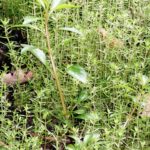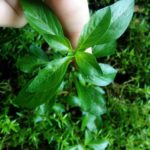Karen Harper, LISI Manager
Of course, having avidly read my previous GiGLer articles, you will know all about the invasive non-native species Ludwigia grandiflora. But what you might not know is that there are other types of Ludwigia growing in London as well.
Meet Ludwigia x kentiana, or Kent’s Hampshire-Purslane, a nondescript small hybrid herbaceous aquatic plant currently identified in only one London pond. Its morphology indicates its parentage to be L. palustris and L. repens and it was only formally described in 2000¹.
Sounds pretty exciting so far, right? Well it is, but sadly for all the wrong reasons. In its little pond in London it is flourishing, spreading and growing happily. Despite the pond being nearly 90% overrun with the non-native invasive New Zealand pigmyweed (Crassula helmsi), this new, nondescript non-native is happily competing for both nutrients and space. And winning.
For those who have dealt with New Zealand pigmyweed you will be as concerned as we were when it became clear to us that the L. x kentiana was happy in this pond. Not much was known about this species when it was first brought to our attention so we turned to GiGL. Had it been recorded anywhere else? Had it already spread? The answer was there in GiGL’s database. This was the only recorded population in the wild; although it is thought that others exist in aquaria which are probably the origin of the wild population.
Since it was identified as an invasive non-native species, we have been working to manage L. x kentiana. The Environment Agency has been providing people power to manually remove the plant from its pond, and we expect to visit the pond again over the next few years to ensure that it has gone completely.
People have said to me ‘but its only one pond what damage can it really do?’ This raises a very important issue, and so I refer to a report completed in 1961 which documents New Zealand pigmyweed in the UK. It shows only three known locations of the plant, with evidence that they all came from one nursery². This means that since the 1960’s those three sites have supplied the UK with all the New Zealand pigmyweed it has today.
In hindsight, if those three populations had been eradicated when first identified we would have been spared the damage that New Zealand pigmyweed now causes – although we would never have known what that damage would be. It is the same with the L. x kentiana. Prevention is better than a cure, so for now we will continue to work on removing and containing it, and if we do our job properly no one will ever find out what they have been spared.
____________________________________________________________________
¹ Clement, E. J. 2000. Ludwigia x kentiana E.J. Clement: a new hybrid aquatic. Watsonia, 23:167-172.
² Laundon, J.R. 1961. An Australian species of crassula introduced into Britain. Watsonia, 5
_____________________________________________________________________
Karen Harper is London’s Invasive Species Initiative manager. Hosted by GiGL, she’s in a unique position to respond rapidly to records of new non-native invasive species in London. She helps ensure the GiGL species data represents the known distribution of non-native invasive species in London, as well as providing assistance and advice to GiGL partners to manage their land holdings where invasive species are present.


